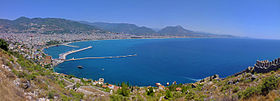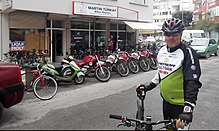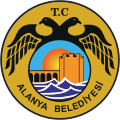Alanya
| Alanya | ||||
|
||||
 Alanya Bay |
||||
| Basic data | ||||
|---|---|---|---|---|
| Province (il) : | Antalya | |||
| Coordinates : | 36 ° 33 ′ N , 32 ° 0 ′ E | |||
| Height : | 7 m | |||
| Telephone code : | (+90) 242 | |||
| Postal code : | 07 4xx | |||
| License plate : | 07 | |||
| Structure and administration (as of 2019) | ||||
| Structure : | 102 Mahalle | |||
| Mayor : | Adem Murat Yücel ( MHP ) | |||
| Postal address : | Güllerpınarı Mahallesi İzzet Azakoğlu Caddesi No: 58 07400 Alanya / Antalya |
|||
| Website: | ||||
| Alanya district | ||||
| Residents : | 312,319 (2018) | |||
| Surface: | 1,577 km² | |||
| Population density : | 198 inhabitants per km² | |||
| Kaymakam : | Mustafa Harputlu | |||
| Website (Kaymakam): | ||||
Alanya is a city in the district of the same name in the Turkish province of Antalya and at the same time a district of the Büyükşehir belediyesi Antalya (metropolitan municipality / metropolitan province ) created in 1993 . The seaside resort, which lies on the Turkish Riviera , is located about 135 km east of Antalya .
Origin of name
The name of the city comes from the 13th century, from Ala-iye , "City of Ala". Since the city was used in the 13th century as the winter residence of the Seljuk Sultan of Rum , Alaeddin Kai Kobad I , the city was named after the Sultan Alaiye . In Latin sources, the city is usually called Alaya. The city was given its current name Alanya in 1933 from Kemal Ataturk .
history
The ancient Greek name Alanyas is Korakesion (German Rabenhorst ). It belonged to the area of Pamphylia , but is sometimes also included in the Rough Cilicia .
The name refers to the hilly rocky promontory protruding far into the sea on which the ancient city was built. The top of the hill was equipped with a defensive wall in the Hellenistic phase. At the beginning of the 2nd century BC The city could face a siege by the Seleucid king Antiochus III. oppose. After that it became a base for Cilician pirates . Middle of the 2nd century BC The Seleucid regent Diodotos Tryphon used the fortress there as a base in his fight against the kings Demetrios II and Antiochus VII. The pirates were finally killed in 67 BC. Defeated by Pompey . During the Roman Empire, Korakesion minted its own coins. The titular Coracesium of the Roman Catholic Church goes back to a late antique bishopric of the city .
In Byzantine times the place was called Kalon oros (beautiful mountain) . A church in the fortress (11th century) dates from this period. In 1221 the Seljuk Sultan Alaeddin Kai Kobad I took the city and named it Alaiye . The ruler Kyr Vart was deported to Konya- Akşehir. Afterwards, Kyr Vart's daughter married the Sultan and was later buried in Kayseri in the Huand Hatun House (1237).
After the fall of the Seljuk Empire, the area was annexed to the Ottoman Empire in 1471 . Together with Tarsus it belonged to Cyprus in 1571, again to Konya in 1864 and, since 1868, to Antalya or this province.
Population development
With 312,319 inhabitants, Alanya is the third largest district behind Muratpaşa and Kepez , which form the city center of Antalya . After the regional reform of 2013, all 16 existing municipalities ( Belediye ) were incorporated, resulting in the population increase in 2013. The inner city has around 104,000 inhabitants. Around 15,400 Europeans live in Alanya. The following table shows the annual population development at the end of the year after updating by the addressable population register (ADNKS) introduced in 2007.
| year | population | change |
|---|---|---|
| 2007 | 91713 | |
| 2008 | 92223 | 0.56% |
| 2009 | 94316 | 2.27% |
| 2010 | 98627 | 4.57% |
| 2011 | 103673 | 5.12% |
| 2012 | 104573 | 0.87% |
| year | population | change |
|---|---|---|
| 2013 | 276277 | 164.20% |
| 2014 | 285407 | 3.30% |
| 2015 | 291643 | 2.18% |
| 2016 | 294558 | 1.00% |
| 2017 | 299464 | 1.67% |
| 2018 | 312319 | 4.29% |
The castle hill
The castle hill consists of three sectors, each surrounded by walls. The outer sector includes important buildings from the Seljuk period such as the shipyard (Turkish Tersane ) and the Red Tower ( Turkish Kızıl Kule ). The tower is 33 m high and was built in 1224–1228 to protect the harbor. In the middle sector there is a bathhouse and the Suleymaniye Mosque. The third sector is the citadel - İç Kale , the origin of the complex. There, next to the Byzantine church, there was the sultan's palace, cisterns and barracks.
tourism
In 1948 the Damlataş Cave was discovered during port work . The first investigations were conducted by a citizen of Alanya, Galip Dere. He had heard from Germany about the healing effects of the cave air and had the healing effects on the respiratory system confirmed in corresponding studies. He was given permission to enlarge the entrance area and then sent photos to newspapers across Turkey. With that the tourist tradition in Alanya began.
In 2012, Alanya visited more than 50,000 German vacationers. In the summer of 2013, German airlines received landing permits for the first time at Gazipaşa Airport , which is about 40 kilometers from Alanya.
Attractions
- Alanya Castle - In the 2nd century BC This was further fortified and expanded.
- Red tower in brick construction at the harbor, 33 m high; the tower is used as an ethnographic museum.
- Seljuk Shipyard
- Castle hill of Alanya with the old city center and mosque
- Caravanserais Şarapsa Han in Konaklı (approx. 15 ㎞ west.) And Alara Han near Çakallar (near Okurcalar approx. 40 ㎞ west.)
- "Tophane" district between the castle wall and the Red Tower
- At the foot of the castle hill is the Damlataş cave ( stalactite cave ) with a constant temperature of 22 ° C and 96% humidity
- Archaeological Museum
- Cleopatra Beach to the west of the city
- the "Dimhöhle", officially accessible since 1998 - about 15 km from the center
- the Aşıklar Cave ( Aşıklar Mağarası )
- the river Dim Çayı with many picnic restaurants
- further east the city of Anamur with the castle worth seeing and the historical city of Anemurion .
- 900 meter long cable car Alanya Teleferik with 14 cabins between the beach and the castle, opened in 2017
Town twinning
Alanya maintains partnerships with the following cities:
-
 Borås , Sweden
Borås , Sweden
-
 Fushun , People's Republic of China
Fushun , People's Republic of China
-
 Gladbeck , Germany
Gladbeck , Germany
-
 Goa , India
Goa , India
-
 Keszthely , Hungary
Keszthely , Hungary
-
 Mahdia , Tunisia
Mahdia , Tunisia
-
 Murmansk , Russia
Murmansk , Russia
-
 Nea Ionia , Greece
Nea Ionia , Greece
-
 Rovaniemi , Finland
Rovaniemi , Finland
-
 Špindlerův Mlýn , Czech Republic
Špindlerův Mlýn , Czech Republic
-
 Talsi , Latvia
Talsi , Latvia
-
 Trakai , Lithuania
Trakai , Lithuania
-
 Wodzisław Śląski , Poland
Wodzisław Śląski , Poland
-
 Çatalca , Turkey
Çatalca , Turkey
-
 Geoagiu , Romania
Geoagiu , Romania
-
 Nowy Sacz , Poland
Nowy Sacz , Poland
-
 Oer-Erkenschwick , Germany
Oer-Erkenschwick , Germany
-
 Turek , Poland
Turek , Poland
-
 Zelenogorsk , Russia
Zelenogorsk , Russia
-
 Dergachi , Russia
Dergachi , Russia
-
 Wronki , Poland
Wronki , Poland
-
 Silute , Lithuania
Silute , Lithuania
-
 Southeast Administrative District , Russia
Southeast Administrative District , Russia
Foreigners in Alanya

A large number of German repatriates live in Alanya (around 10,000 in 2006). Due to the large number of Germans, Alanya is sometimes referred to as "Almanya" (Germany) by the Turks living in the Mediterranean region.
Alanya is the only city in Turkey to have an advisory board for foreigners made up of voluntary members from various nations. He can take part in city council meetings in an advisory capacity on relevant topics. Foreigners who need advice can contact the advisory board.
The immigration police near the bus station (“Otogar”), where residence permits are applied for if the stay is longer than 90 days, employs a German and English speaking officer.
Another large group of Russian emigrants , unlike the Germans, has their own school. In addition, many Scandinavians live in Alanya, especially Danes and also Dutch, who concentrate on the eastern district of Mahmutlar .
There is a Christian community in Alanya. She is connected to the Catholic community in Antalya in the St. Nicholas Association. A pastor is sent to Antalya via the Catholic Bishops' Conference, the ecumenical congregation in Alanya always has a retired pastor via the Evangelical Church in Germany. The congregation has had its own premises since 2013, in which other activities take place in addition to the church service. There is close ecumenical cooperation with other Christian churches (Norwegians, Dutch).
sons and daughters of the town
- Mevlüt Çavuşoğlu (* 1968), politician (AKP)
- Can Öncü (* 2003), motorcycle racer
Impressions from Alanya
Byzantine Church in the Citadel - Iç Kale
literature
- George Ewart Bean : Korakesion (Alânya) Turkey . In: Richard Stillwell et al. a. (Ed.): The Princeton Encyclopedia of Classical Sites. Princeton University Press, Princeton NJ 1976, ISBN 0-691-03542-3 .
- Hansgerd Hellenkemper , Friedrich Hild : Lycia and Pamphylia, Tabula Imperii Byzantini 8 . Vienna 2004. ISBN 3-7001-3280-8 , pp. 587-594 (with sources and rich literature on history and monuments).
- Scott Redford: Landscape and the state in medieval Anatolia. Seljuk gardens and pavilions of Alanya, Turkey . Oxford 2000 (BAR international series 893). ISBN 1-84171-095-4 .
- Haşim Yetkin: From the past to the modern age - Alanya . Alanya.
Web links
Individual evidence
- ↑ Türkiye Nüfusu , accessed on September 4, 2019
- ↑ Strabo , Geographika 14,5,2.
- ↑ Central Dissemination System / Merkezi Dağıtım Sistemi (MEDAS) of the TÜIK , accessed on September 4, 2019
- ↑ Report in the tourism magazine FVW from June 21, 2013.
- ↑ Kardeş Şehirler / Twin Cities , accessed on September 4, 2019
- ↑ https://www.dailysabah.com/deutsch/tuerkei/2017/08/03/beheimatet-und-berufstaetig-tausende-glueckliche-deutsche-in-alanya At home and at work: Thousands of happy Germans in Alanya, accessed on 9. February 2018
- ^ Church in Alanya
















